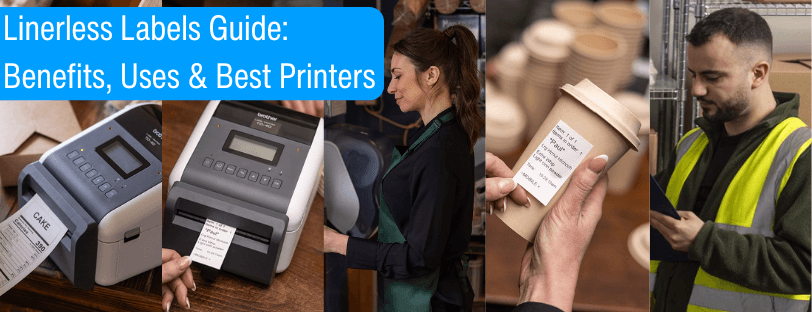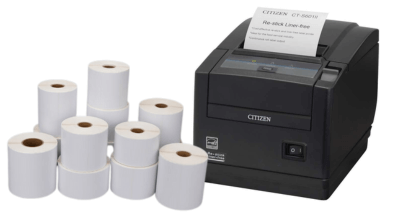
Linerless labels are reshaping how businesses approach labelling, offering a sustainable, cost-effective alternative to traditional adhesive labels with backing liners. Whether you’re in logistics, retail, healthcare, or manufacturing, switching to linerless labels can make a real difference in efficiency, safety, and eco-credentials.
In this guide, we’ll explore everything you need to know about linerless labels and printers. What they are, how they work, and why more businesses are choosing them.

What Are Linerless Labels (and How Are They Made)?
Linerless labels are adhesive labels that do not have a backing liner. Instead, they use a special adhesive combined with a release coating, allowing the labels to stay neatly rolled without sticking together.
When printed and applied, linerless labels offer strong adhesion to a wide range of surfaces, all without the waste, clutter, or issues associated with traditional liner-backed labels.
Most linerless labels are made from direct thermal paper or durable synthetic materials. A top release coating ensures that while the adhesive stays effective for application, it won’t cause the labels to bond to each other on the roll.
Some linerless label materials are enhanced for moisture resistance, abrasion durability, or outdoor-grade toughness. However, the majority are designed for short to medium-term applications.
How to Print with Linerless Labels: Step-by-Step Guide
Printing with linerless labels is straightforward, but it does require the right equipment. Follow these steps to print with linerless labels using compatible equipment and media.
1. Load The Media
Insert a continuous roll of linerless labels into a linerless-compatible printer. These specialised printers are designed to manage exposed adhesives without causing jams, damage, or adhesive build-up.
2. Print The Design
The printer uses direct thermal technology, applying heat to the surface of the label to create text, barcodes, graphics, or compliance information – without requiring ink, ribbons or toner.
3. Cut To Size
After printing, the printer’s integrated auto-cutter cleanly slices the label to the exact length needed. Whether you need small product tags or large shipping labels, the system adjusts on demand without the need to change media.
4. Apply The Label
The printed label is ready for immediate application, offering strong adhesion to a variety of surfaces – and crucially, there’s no liner waste to manage or dispose of.
Key Benefits of Linerless Labels
- Cost efficiency – With no liner waste to manage and fewer raw materials used in production, linerless labels lower both material and disposal costs
- Eco-Friendly sustainability – Choosing linerless labels supports environmental goals by reducing landfill waste and conserving resources.
- Improved health & safety – Eliminating discarded liners means fewer trip hazards and a cleaner workspace, crucial for busy environments like warehouses and production floors.
- Flexible printing options – Since linerless labels are printed and cut to size on demand, businesses can easily create variable-sized labels without changing media rolls.
Limitations Of Linerless Labels
- Monochrome printing only – Most linerless labels are suited for black-and-white (direct thermal) printing only.
- Temperature sensitivity – Standard linerless labels may not perform optimally in extreme heat or cold unless a specialist material is chosen.
- Slightly higher roll costs – While the upfront price per roll can be higher, overall savings on waste handling and material use typically lower the total cost of ownership.
Why More Businesses Are Switching To Linerless Labelling
Linerless labels offer an unbeatable combination of cost savings, sustainability, operational flexibility, and safer working environments. Whether you’re labelling shipping cartons, takeout containers, retail shelving, or healthcare supplies, linerless printing solutions help future-proof your operations while supporting your business’s eco-friendly goals.
What Is A Linerless Label Printer?
A linerless label printer looks similar to a regular thermal label printer but includes key upgrades to handle the unique nature of linerless labels:
- Adhesive management – Prevents exposed adhesive from sticking inside the printer.
- Built-In cutter – Since linerless labels come on a continuous roll, the printer must cut each label to size cleanly.
- Heat adjustment – Linerless labels react to lower temperatures, so printers use optimised thermal settings to avoid damaging the adhesive coating.
Where Can A Linerless Printer Be Used?
Linerless labels are versatile and used across industries:
- Retail – Shelf edge labels, promotional stickers
- Logistics & warehousing – Shipping labels, pallet tags
- Hospitality – Takeaway orders, food delivery packaging
- Healthcare – Specimen labelling, asset tracking
- Manufacturing – Product ID labels, compliance stickers
If you need to use labels immediately after printing and want to avoid waste build-up, a linerless printer is ideal.
Can All Label Printers Print Linerless?
Not all label printers are compatible with linerless labels. Standard thermal printers are typically designed for labels with a backing liner. Since linerless media has exposed adhesive, using it in an incompatible printer can cause serious issues, including printhead damage, adhesive build-up and paper jams.
To print linerless labels safely and reliably, you’ll need a printer that is specifically built or approved for linerless media. These printers feature protective coatings, adhesive management systems, and built-in cutters to handle the unique properties of linerless rolls.
How To Check If Your Printer Is Compatible With Linerless Labels
Before using linerless labels, it’s important to confirm whether your printer is compatible. Here’s how:
- Check your user manual – Look for mentions of “linerless media support” or specific linerless settings
- Review product specifications – Manufacturers often list linerless compatibility in technical datasheets
- Ask an expert – Still unsure? Reach out to the Printerbase team. Our trained advisors can quickly confirm compatibility or recommend the best linerless-ready printers for your needs.
Recommended Linerless Label Printers
Choosing the right linerless label printer can have a major impact on your operational efficiency, sustainability goals, and cost control. Below, we highlight two outstanding linerless label printers that suit a range of business needs and environments.
Honeywell PC45D Direct Thermal Linerless Label Printer
Key Features:
- Print technology: Direct Thermal
- Print resolution: 203 DPI or optional 300 DPI for final print detail
- Print speed: Up to 8 inches per second for fast turnaround
- Media handling: Supports linerless labels with an integrated auto-cutter for precise, clean cuts
- Connectivity: Offers USB, Ethernet, Wi-Fi 5, and Bluetooth 5.1 LE for flexible network integration
- User interface: Intuitive full-colour touchscreen for easy configuration and maintenance
- Printer management: Honeywell Printer Edge compatibility for real-time monitoring, updates, and remote troubleshooting
The Honewell PC45D is a powerful desktop label printer built for demanding environments where reliability, speed, and flexibility are essential. Specifically designed for linerless label applications, the PC45D offers exceptional durability and performance, making it a smart investment for logistics hubs, healthcare facilities, retail operations, and manufacturing floors.
This label printer is ideal if you need a high-volume, high-speed solution that can handle demanding print environments while helping you transition toward more sustainable operations. Its rugged construction and enterprise-grade features ensure dependable performance day after day, even in busy industrial settings.
Brother RJ-3250WB Mobile Printer
Key Features:
- Print technology: Direct Thermal
- Print resolution: Crisp 203 DPI for clear barcodes, shipping labels, and receipts
- Print speed: Up to 5 inches per second (3 IPS when using linerless platen)
- Media handling: Supports linerless labels when equipped with an optional linerless platen kit
- Connectivity: Equipped with USB-C, Bluetooth 5.0, dual-band Wi-Fi (2.4GHz and 5GHz), and NFC pairing
- Durability: IP54-rated protection against dust and water, drop-tested up to 2 meters without needing a case
- Battery performance: Features a smart Li-ion battery for all-day printing on a single charge
The Brother RJ-3250WB is a compact and durable mobile printer tailored for field workers, delivery drivers, warehousing teams, and retail associates who need reliable linerless printing on the move. Despite its small size, this printer delivers impressive output quality and speed, even in tough conditions.
This label printer model is the go-to choice if you need portability without sacrificing performance. It’s rugged enough to withstand fieldwork conditions yet versatile enough to integrate into office environments when needed. This makes it perfect for mobile sales, order fulfilment, ticketing, and on-site customer service.
What Is Liner Waste?
Liner waste refers to the discarded backing paper (also called a “release liner”) left behind when using traditional labels. This liner, typically made from paper or plastic with a silicone coating, serves no purpose once the label is peeled off and applied.
While it helps protect and deliver standard labels, liner waste contributes heavily to landfill volume. In high-label-use industries like logistics, manufacturing, and retail, liner waste can accumulate into significant environmental and operational challenges.
Why Liner Waste Is A Problem
- Environmental Impact
Liner waste is difficult to recycle due to the silicone or plastic coatings that prevent easy processing. As a result, most discarded liners end up in landfills, adding to environmental strain. - Higher Operating Costs
Managing liner waste increases business expenses. Waste collection, handling, and disposal fees – especially in high-volume operations – add hidden costs to traditional label printing. - Health & Safety Risks
Discarded liner strips on warehouse or shop floors can create serious trip hazards. Eliminating liner water promotes a cleaner, safer work environment for employees.
Final Thoughts
Switching to linerless labels and investing in the right printer helps reduce waste, cut operational costs, improve workplace safety, and add flexibility to your labelling process – delivering real, measurable business value.
Explore our range of linerless printers and take the next step toward faster, safer and more sustainable operations.
Need Help or More Information ?
If you need any further help or more information, reach out to us by leaving a comment below or through one of the many ways on our Contact Us page.
Alternatively you can contact us by Phone on 0161 308 5800 or by Live Chat on our main Website Monday to Friday and our team will be happy to help or answer with any questions you might have.
You can also find all the various ways to connect with Us at the bottom of this page. Please share this post if you found it helpful.

